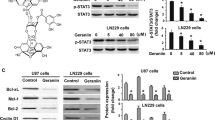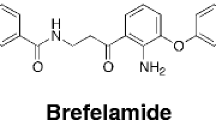Abstract
Human glioblastomas (gliomas) are characterized as highly invasive and rapidly growing brain tumors. In this study, we present data on in vitro effect of ascorbyl stearate (Asc-S), a liphophilic derivative of ascorbic acid on cell proliferation, transformation, apoptosis and modulation of expression of insulin-like growth factor-I receptor (IGF-IR) in human glioblastoma multiforme (T98G) cells. Asc-S showed significant inhibition of fetal bovine serum and human recombinant insulin-like growth factor-I (IGF-I) dependent cell proliferation in a dose dependent manner. Treatment of T98G cells with 0, 50, 100 and 150 μM Asc-S for 24 h slowed down the cell multiplication cycle with significant accumulation of cells at late S/G2-M phase of cycle. Asc-S treatment (100 μM) reversed the transformed phenotype as determined by clonogenecity in soft agar and also induced apoptosis of T98G. These changes were found to be associated with significant decrease in IGF-IR expression in dose and time dependent manner compared to untreated controls. The data clearly demonstrate that Asc-S has antiproliferative and apoptotic effect on T98G cells probably through modulation of IGF-IR expression and consequent facilitation of programmed cell death.
Similar content being viewed by others
References
Russel DS, Rubenstein LJ: Pathology of Tumors of the Nervous System, 5th edn. Baltimore, Williams & Wilkins, 1989
Black PM: Brain tumors (Parts I and II). N Engl J Med 324: 1471–1476, 1991
Mahaley MS Jr: Neuro-oncology index and review (Adult primary brain tumors radiotherapy, chemotherapy, immunotherapy, photodynamic therapy). J Neuro-Oncol 11: 85–147, 1991
Greenle GT, Murray T, Bolden S, Wingo PA: Cancer statistics 2000. CA Cancer J Clin 50: 7–33, 2000
Leung PY, Miyashita K, Young M, Tsao CS: Cytotoxic effect of ascorbate and its derivatives on cultured malignant and nonmalignant cell line. Anticancer Res 13: 475–480, 1993
Roomi MW, House D, Eckert-Maksic M, Masksic ZB, Tsao CS: Growth suppression of malignant leukemia cell line in vitro by ascorbic acid (vitamin C) and its derivatives. Cancer Lett 122: 93–99, 1998
Habib NA, Wood CB, Apostolov K, Barker W, Hershman MJ, Aslam M, Heinemenn D, Fermor B, Williamson RCN, Jenkins WE, Masters JRW, Embleton MJ: Stearic acid and carcinogenesis. Brit J Cancer 56: 455–458, 1987
Pauling L: Effect of ascorbic acid on incidence of spontaneous mammary tumors and UV light induced skin tumors in mice. Am J Clin Nutr 54: 1252S–1255S, 1991
Ibric LLV, Peterson AR, Sevanian A: Mechanism of ascorbic acid induced inhibition of chemical transformation in C3H/1OT1/2 cells. Am J Clin Nutr 54: 1236S–1240S, 1991
Block G: Vitamin C and cancer prevention: the epidemiological evidence. Am J Cin Nutr 53: 270S–282S, 1991
Liehr JG: Vitamin C reduces the incidence and severity of renal tumors induced by estradiol and deithylstilbesterol. Am J Clin Nutr 54: 1256S–1260S, 1991
Mitra A, Govindwar S, Kulkarni AP: Inhibition of hepatic glutathione S-transferase by fatty acids and fatty acid esters. Toxicol Lett 58: 135–141, 1991
Mitra A, Govindwar S, Joseph P, Kulkarni AP: Inhibition of Human placental and fetal liver glutathione S-transferase by fatty acids and fatty acid esters. Toxicol Lett 60: 281–288, 1992
Banks WA, Kastin AJ: Peptides and blood-brain barrier: liphophilicity as predictor of permeability. Brain Res Bull 15: 287–292, 1985
Naidu AK, Wiranowska M, Kori SH, Roetzheim KC, Kulkarni AP: Inhibition of human glioma cell proliferation and glutathione S-transferase by ascorbyl esters and interferon. Anticancer Res 13: 1469–1471, 1993
Naidu AK, Wiranowska M, Kori SH, Prockop LD, Kulkarni AP: Inhibition of human glioma cell proliferation and glutathione S-transferase by ascorbyl esters and interferon in mouse glioma. J Neuro-Oncol 16: 1–10, 1993
Zumkeller W, Biernoth R, Kocialkowski S, Martinerie C, Schofield PN, Perbal B, Westphal M: Expression and synthesis of insulin-like growth factor (IGF)-I,-II and their receptors in human glioma cell lines. Int J Oncol 9: 983–992, 1998
Sandberg-Norquist AC, Stahlborn PA, Reinecke M, Collins VP, vonHolst H, Sara V: Characterization of insulin-like growth factor-I in human primary tumors. Cancer Res 53: 2475–2478, 1993
Sell C, Dumenil G, Devaud C, Miura M, Coppola D, De Angelis T, Efstratiadia A, Beserga R: Effect of a null mutation of the type 1 IGF receptor gene on growth and transformation of mouse embryo fibroblast. Mol Cell Biol 14: 3604–3612, 1994
Eckert-Maksic M, Kovacek ZB, Maksic M, Osmak KP: Effect of ascorbic acid and its derivatives on different tumors in vivo and in vitro, In: Maksic ZB, Eckert Maksic M (eds) Molecules in Natural Science and Medicine. An Encomium for Linus Pauling Ellis Horwood. New York, 1991, pp 509–524
Makino Y, Sakagami H, Takeda M: Induction of cell death by ascorbic acid derivatives in human renal carcinoma and glioblastoma cell lines. Anticancer Res 19: 3125–3132, 1999
Baserga R, Hongo A, Rubin M, Prisco M, Valentinis B: The IGF-I receptor in cell growth, transformation and apoptosis. Biochim Biophys Acta 1332: 105–126, 1997
Coppola D, Ferber A, Miura M, Sell C, D'Ambrosio C, Rubin R, Baserga R: A functional insulin-like growth factor I receptor is required for the mitogenic and transforming activities of the epidermal growth factor receptor. Mol Cell Biol 14: 4588–4595, 1994
De Angelis T, Ferber A, Baserga R: Insulin-like growth factor I receptor is required for the mitogenic and transforming activities of the platelet-derived growth factor receptor. J Cell Physiol 164: 214–221, 1995
Pardee AB: GI events and regulation of cell proliferation. Science 246: 603–605, 1989
Bijur GN, Briggs B, Hitchcock CL, Williams MV: Ascorbic acid-dehydroascorbate induces cell cycle arrest G2/M DNA damage check point during oxidative stress. Environ Mol Mutagen 33: 144–152, 1999
Sara VR, Carlsson-Skwirut C: The role of insulin-like growth factors in the regulation of brain development. Prog Brain Res 73: 87–99, 1988
Baskin DG, Wilcox BJ, Figlewicz DP, Dorsa DM: Insulin-like growth factors in CNS. Trends Neurosci 11: 107–111, 1988
LeRoith D, Werner H, Beitner-Johnson D, Roberts CT Jr: Molecular and cellular aspects of insulin-like growth factor I receptor. Endocrine Rev 16: 143–163, 1995
Butler AA, Yakar S, Gewolb IH, Karas M, Okubo Y, LeRoith D: Insulin like growth factor-I receptor signal transduction: At the interface between physiology and cell biology. Comp Biochem Physiol B Biochem Mol Biol 121: 19–26, 1998
Petley T, Graff K, Jiang W, Yang H, Florini J: Variation among cell types in the signaling pathways by which IGF-I stimulates specific cellular responses. Horm Metab Res 31: 70–76, 1999
Valentinis B, Romano G, Peruzzi F, Morrione A, Prisco M, Soddu S, Cristofanelli B, Sacchi A, Baserga R: Growth and differentation signals by the insulin-like growth factor I receptor in hemopoietic cells are mediated through different pathways. J Biol Chem 274: 12423–12430, 1999
Resnicoff M, Burgaud JL, Rotman HL, Abraham D, Baserga R: Correlation between apoptosis, tumorigenesis and levels of insulin-like growth factor I receptors. Cancer Res 55: 3739–3741, 1995
Gammeltoft S, Ballotti R, Kowalski A, Westermark B, Van Obberghen E: Expression of two types of receptor for insulin-like growth factors in human malignant gliomas. Cancer Res 48: 1233–1237, 1988
Glick RP, Gettleman R, Patel K, Lakshman R, Tsibris JCM: Insulin and insulin-like growth factor I in brain tumors: binding and in vitro effects. Neurosurgery 24, 791–797, 1989
Merrill MJ, Edwards NA: Insulin-like growth factor-I receptors in human glial tumors. J Clin Endo Metab 71: 199–209, 1990
Sandberg Ac, Engberg C, Lake M, von Holst H, Sara VR: The expression of insulin-like growth factor I and insulin-like growth factor genes in human fetal and adult brain and glioma. Neurosci Lett 93: 114–119, 1988
Trojan J, Jhonson TR, Rudin SD, Ilan J, Tykocinski M, Ilan J: Treatment and prevention of rat glioblastoma by immunogenic C6 cells expressing antisense insulin-like growth factor 1 RNA. Science 259: 94–97, 1993
Resnicoff M, Sell C, Rubini R, Coppola D, Ambrose D, Baserga R, Rubin R: Rat glioblastoma cell expressing an antisense RNA to the insulin-like growth factor-I (IGF-I) receptor are nontumourigenic and induce regression of wild type tumors. Cancer Res 54: 2218–2222, 1994
Resnicoff M, Li W, Basak S, Heryln D, Baserga R, Rubin R: Inhibition of rat C6 glioblastoma tumor growth by expression of insulin-like growth factor-I receptor antisense mRNA. Cancer Immunol Immunother 42: 64–68, 1996
Ambrose D, Resnicoff M, Coppola D, Sell C, Miura C, Jameson S, Beserga R, Rubini R: Growth regulation of human glioblastoma T98G cells by insulin like-growth factor-1 and its receptor. J Cell Physiol 159: 92–100, 1994
Rininsland F, Hohnson TR, Chernicky CL, Schulze E, Burteind O, Ilan J: Suppression of insulin like-growth factor type I receptor by a triplex-helix strategy inhibits IGF-I transcription and tumorigenic potential of rat C6 glioblastoma cells. Proc Natl Acad Sci USA 94: 5854–5859, 1997
Park CH, Mammo A, Savin MA, Hoogstraten B: Growth suppression of human leukemia cell in vivo by l-ascorbic acid. Cancer Res 40: 1062–1065, 1980
Tsao CS: Inhibiting effect of ascorbic acid on growth of human mammary tumor xenografts. Am J Clin Nutr 54: 1274S–1280S, 1991
Medina MA, De Vegas RG, Schweigerer B: Ascorbic acid is cytotoxic for pedioatric tumor cells cultured in vitro. Biochem Mol Biol Inter 34: 871–874, 1994
Drake IM, Davies MJ, Mapstone NP, Dixon MF, Schorah CJ, White KL, Chalmers Dm, Axon AT: Ascorbic acid may protect against human gastric cancer by scavenging mucosal oxygen radicals. Carcinogenesis 17: 559–562, 1996
Sakagami H, Satoh K, Kochi M: Comparitive study of the antitumor action between sodium 5,6-benzylidene-lascorbate and sodium ascorbate (mini review). Anticancer Res 17: 4451–4452, 1997
Roomi MW, House D, Tsao CS: Cytotoxic effect of substitution at 2-,6-, and 2,6-positions in ascorbic acid on malignant cell line. Cancer Biochem Biophys 16: 295–300, 1998
Kaneko T, Kaji K, Mastuo M: Protective effect of liphophilic derivatives of ascorbic acid on lipid peroxide-induced endothelial injury. Arch Biochem Biophys 304(1): 176–180, 1993
Sakagami H, Satoh K, Ohata H, Takahashi H, Iida M, Kuribayashi N, Sakagami T, Momose K, Takeda M: Relationship between ascorbyl radical intensity and apoptosis-inducing activity. Anticancer Res 16: 2635–2644, 1996
Sakagami H, Satoh K, Hakeda Y, Kumegawa M: Apoptosis inducing activity of vitamin C and K. Cell Mol Biol (Noisy-le-grand) 46: 129–143, 2000
Author information
Authors and Affiliations
Rights and permissions
About this article
Cite this article
Naidu, K.A., Liu Tang, J., Akhilender Naidu, K. et al. Antiproliferative and apoptotic effect of ascorbyl stearate in human glioblastoma multiforme cells: modulation of insulin-like growth factor-I receptor (IGF-IR) expression. J Neurooncol 54, 15–22 (2001). https://doi.org/10.1023/A:1012545311054
Issue Date:
DOI: https://doi.org/10.1023/A:1012545311054




